Under the blow "ram" Mackensen
The Gorlitsk operation is multi-step and includes the following stages: tactical and operational breakthrough of the defense of the 3 army (19 - April 22); fighting on the river. Visloka and departure to r. San (23 - April 30); battle on p. San and fight for bridgeheads at Yaroslav, Radymno and Senyavy (1 - May 15); Lyubachev battles, the struggle for Przemysl, the Gorodok battle, the Lvov operation (May 19 - June 10).
In this article, we recall the Gorlitsky breakthrough - the tactical breakthrough of the 3 defense of the South-Western Front by 19 - 20 in April of 1915 and which gave the name to the whole operation.
In the midst of the collapse of the "Winter Strategic Cannes", the High Command of the German bloc planned a new major offensive strategic operation. Taking into account the critical situation of the Austro-Hungarian armed forces, as well as the significant weakening of the armies of the South-Western Front during the Carpathian operation, the region of Carpathian western Galicia, near the town of Gorlitsa, was chosen as a breakthrough for the Russian defense.
Positions of the South-Western Front to the beginning of the Gorlitsk operation. Russian map. Collection of documents. Gorlitsky operation. M., 1941.
When choosing a breakthrough site for Gorlitsa, the fact that the flanks of the shock group reliably covered the Vistula and the Beskids was of no small importance. In addition, the enemy was aware that just in this area the Russian front was most weakly covered, which gave an absolute superiority in forces, especially at the first stage of the operation. In choosing the area of the offensive, the economic factor also played a large role. Thus, in the region of Gorlice, Jaslo, Dorogobich there were large oil sources, and oil under the blockade was extremely necessary for both Germany and its allies.
"Allies are Austro-Germans". German and Austrian officers inspect captured Russian rifles
Due to heavy losses and fatigue of troops, the command of the South-Western Front went over to the defensive. The above factors were superimposed on the peak of the supply crisis with armament and military equipment, while the material part of the troops was largely spent.
The enemy achieved an incredible operational gain on the breakthrough site:
The German 11 Army (Commander Colonel-General A. von Mackensen) (direction of the main attack) consisted of 5 corps: German 4 (Combined, Reserve 41, Army Guards, Austrian 10) and Austrian 1 (6 Army) - 10 infantry divisions, in which there were 126 thousand soldiers, 457 light and 159 heavy guns, 260 machine guns, 96 mortars;
3-I Army of the South-Western Front (Commander General of Infantry R. D. Radko-Dmitriev) (direction of the main attack) - 9-I, 31-I, 61-I and 70-I infantry divisions (in reserve were 7- I have a cavalry division and part of the 63 Infantry Division) in which there were 60 thousand people, 141 light and 4 heavy guns, 100 machine guns.
Higher command personnel of the German 11 Army.
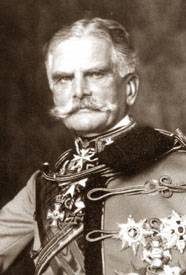
Commander of the German 11 Army, Colonel-General A. von Mackensen
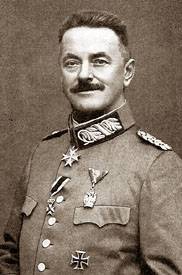
The commander of the Consolidated Corps (in the documents he passed as a corps of names, the “Kneisl Corps”), Major General (he was the chief of the 11 th Bavarian Infantry Division entering the corps), Major General P. P. von Kneissl
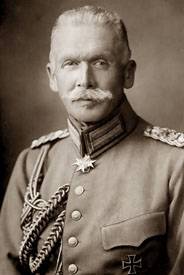
Commander of the Guards Corps, General of the Infantry KF von Plettenberg
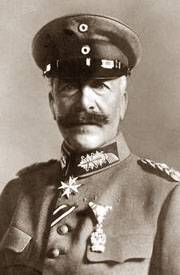
The commander of the 41-th Reserve Corps General Infantry G. von Francois
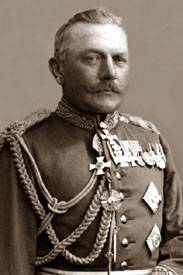
Commander of the 10 Army Corps, General of the Infantry O. von Emmich
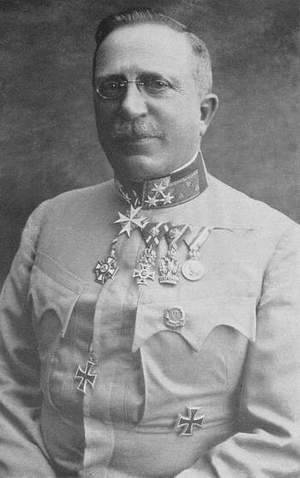
Commander of 6 Army Corps Field Marshal Lieutenant A. von Straussenburg
The command staff of the Russian 3-th army.
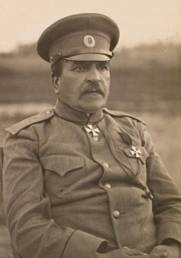
Commander of the 3 Army of the Southwestern Front, General of Infantry R. D. Radko-Dmitriev
Some chiefs (commanders) of divisions in the sector of the main attack of the enemy:
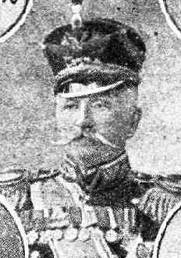
Chief of the 9 Infantry Division Lieutenant General I. S. Loshunov
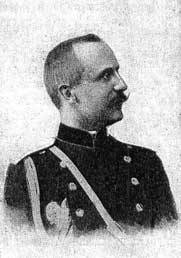
The commander of the 61 Infantry Division, Major General P. N. Simansky
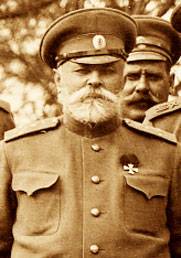
Chief of the 70 Infantry Division Lieutenant-General N.V. Belov
And the overall balance of forces in the operation was as follows:
3 Army of the South-Western Front - 18,5 infantry divisions, about 6 cavalry divisions;
German 11, Austrian 4 and 3 armies - 31,5 infantry and 3 cavalry divisions.
Russian intelligence already 10 days before the strike knew about the impending offensive, but did not have time to take appropriate measures. The current operational-strategic situation determined the extremely unfavorable ratio of forces and means for the Russian army. The degree of preparation of the troops for the upcoming tests was not the same. The operation historian G. Kellerman, evaluating opponents before the breakthrough, noted that the Austro-German troops assigned to the 11 Army practiced in the rear - practicing the methods of combat in breaking through the fortified bands. Another was the situation on the Russian side. The right flank and the center of the 3 Army were a passive sector of the front, covering the attack in Hungary from N. Sandets - and, of course, did not pay much attention to them. The troops of the 3 Army did not have any special preparation for countering the enemy breakthrough. The troops did the whole march and needed rest, and a small number of artillery guns, which also suffered an acute shortage of shells, and the lack of infantry weapons made the Austro-Germans much easier.
Enemy units participating in the operation were fully staffed and equipped, and had a good rest before the operation.
Serious were measures to ensure secrecy and mislead the Russian command. Thus, the Germans implemented a false railway maneuver: the connections intended for participation in the Gorlitsk operation were sent to East Prussia - they turned off to Silesia only from Berlin, Stettin and Poznan (to mislead the Russian intelligence agency). The reconnaissance of Russian positions near Gorlitsa was carried out by German officers dressed in Austrian uniforms (in order to mislead the Russian military intelligence).
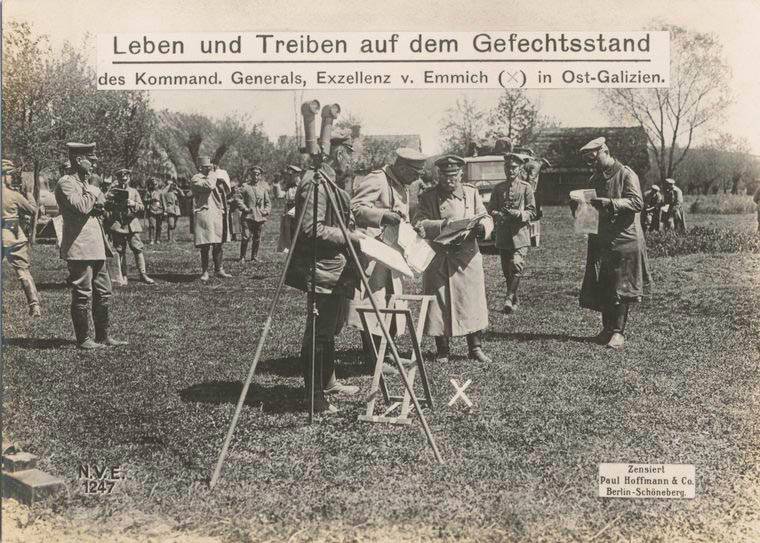
The commander of the German 10 Army Corps, General of the infantry O. von Emmich with headquarters.
The preparation for the operation was also thorough: a detailed photographing of the Russian defensive lines was carried out, so that their infantry would not suffer from their own artillery fire, red-and-white shields were placed on the flanks of the military formations of the formations, and the infantrymen had white braids on the knapsacks. Moreover, the main attack of the enemy was accompanied by diversionary actions on other sectors of the front. The situation was aggravated by the lack of attention to the threatened combat site by the Russian command. But the main prerequisite for future success was the unprecedented power of technical resources introduced in a narrow area — including a significant amount of heavy guns and mortars with an unlimited limit of ammunition.
The artillery support operations included: 1) general artillery preparation; 2) point shooting at identified targets; 3) shooting to destroy. Artillery preparation was supplemented with mortar training. Enemy artillery concentrated fire and transferred it depending on changes in the situation.
The positions of the German-Austrian troops in front of the front of the Russian 3-th army. German map. Battle of Gorlice-Tarnov 2 - 6 May 1915 M. - L., 1929.
The minus of the breakthrough was the lack of a full-fledged rampart, as well as the slow development of the attack - on the 2 day of the last enemy was able to approach only the second line of the trenches.
The study of the Swedish General Staff "Battle of Gorlitsa-Tarnov. An essay on infantry-artillery joint operations noted that in the morning 6 tens of thousands of different-caliber shells flew towards the Russian positions — and from a series of explosions the ground was forwarded to the air, pieces of fortifications and slingshots, beams of platforms, while the trenches seemed to be compared to the ground. Lit forests and villages. German infantry, preceded by pioneer units equipped with hand grenades and wire cutting shears, launched an offensive along the line. The artillery fire was moved to communications, rear positions, marching roads.
Despite all this, the enemy attacks of 19 on April, Russian troops confidently fought off. For example, one of the documents recorded the enemy's artillery fire on the positions of 165-th Lutsk and 168-th Mirgorod infantry regiments - 6-, 8- and 12-inch gauges. The trenches were swept away. The enemy in the area of the 279 th Lokhvitsky infantry regiment of the 70 division seized the height of 430, but then the counterattack was thrown off, losing 250 people captured, while the Russian battery of the enemy swept away.
G. Kellerman noted that in almost all the attacking corps the Austro-German infantry was stopped by Russian machine guns, which opened dagger fire immediately after the Germans carried the artillery fire. And most of the divisions, in order to advance the infantry, again repeated artillery preparation. Nevertheless, the offensive went slowly, and the advancing ones, met with murderous machine-gun fire and flank counterattacks of the Russian infantry, suffered heavy losses.
So, the 11 of the Bavarian division of the Consolidated Corps did not manage to reach the trenches of the defenders at the same time as the transfer of artillery fire - and the Russian machine gun points located at heights managed to “come to life”, pressing the Bavarians to the slopes of the Zamchisko massif. Artillery preparation was resumed. And only after that did the units of the division on the right flank succeed in breaking into the trenches of the defenders, while the attack on the height of the 507 proceeded slowly, accompanied by heavy losses. The regiment, advancing to a height, lost a third of the composition. Finally, the heights of 507 and 469 were taken, but the Russians struck a flank counter-strike, with great difficulty repulsed only after the 14 hours.
At this time, the German 119 Infantry Division led heavy battles (also with heavy losses) at the height of 349.
Infantry 82-th reserve division broke into the churchyard on the outskirts of Gorlice. In 10 hours 15 minutes, after the battle, the Germans occupied the Jewish cemetery south-west of the height 357, and by 11 hours and height. In 11 hours of altitude north of Gorlice were in the hands of the attackers. But the first attack on the city was repelled - and with heavy losses for the German troops.
On the front of the 81-th Reserve Division, things went worse. The results of the artillery preparation were weaker than in the neighboring combat areas - the attackers everywhere encountered the surviving firing points. Heavy losses forced the center and the left flank of the division, after minor initial successes, to lie down. Only the right flank, a neighbor of the 82 reserve, managed to succeed - at the height of the forest 335. New artillery preparation and escort guns helped the left flank of the formation to break into the forest south of the sites. Kamenets. But the center of the division continued to lie in front of Moshanka - only a maneuver through the Kamenetsky forest of the division reserve forced the Russian units to leave their positions at this town.
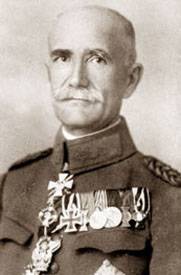
Chief of the 81 Reserve Division, Major General L. von Stoden
On the southern wing of the German 2-th Guards Division turned heavy battle for der. Strike. Flank fire from the Ostrushskoy valley stopped the German attacks and on the heights. Davydovka. The German 3-I Guards Brigade suffered heavy losses.
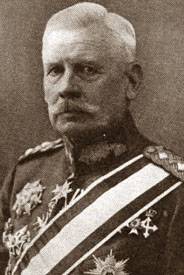
Chief of the 2 Guards Infantry Division, Lieutenant General A. von Winkler
The enemy’s strongest onslaught fell on the positions of the Russian 61 Infantry Division - it was in this sector that he managed to penetrate the Russian defense. During the first day of the battles, the Russian 10 Army Corps was rejected on average 5 km and occupied the front Rzepenik-Roseembark-Bijech and south to Vartne.
To the north of Gorlice, in the combat sector of the 31 Infantry Division, the first attack was repelled with heavy losses for the enemy. To the south of Gorlitsa, the combat section of the 9 Infantry Division was attacked by the Germans together with Austrian units (after night artillery preparation) - this attack was also repulsed.
Thus, the German infantry of most of the attacking corps lay down, not reaching the first Russian trenches. Only in isolated areas, at great losses, did the Germans break into Russian trenches.
The study of the Swedish General Staff noted that the artillery preparation had a certain moral effect on the Russians - the soldiers who were in the trenches in the open area, as well as in the settlements, were often mentally suppressed (according to reports of the German infantry who broke into the position). But when during the infantry attack the artillery fire was moved forward, the well-served Russian machine guns began to operate.
German historian Lieutenant Colonel L. von Rothkirch wrote: "The Russians showed themselves here as brave soldiers and steadfast defenders of the positions entrusted to them."
The result of the 1-th day of the offensive (German data) - penetration into the defense on 2 - 4 km; trophies: several guns, machine guns and up to 17-thousand prisoners.
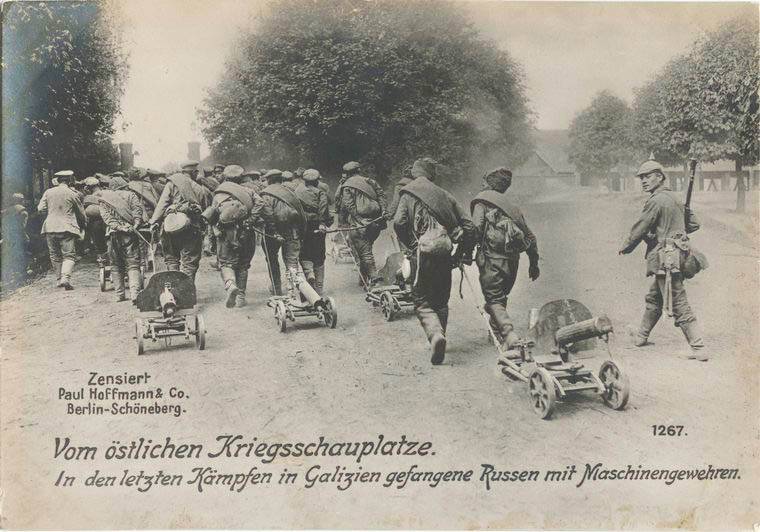
Russian machine guns captured by the Germans
The Austro-Germans, despite the enormous superiority in manpower and artillery, paid dearly for success. For example, the 3 th Bavarian infantry regiment lost on that day up to half of the officers and 600 of the lower ranks, the 269 th reserve regiment of the 81 reserve division was 738 people, and the 82 I division was more than 500 people.
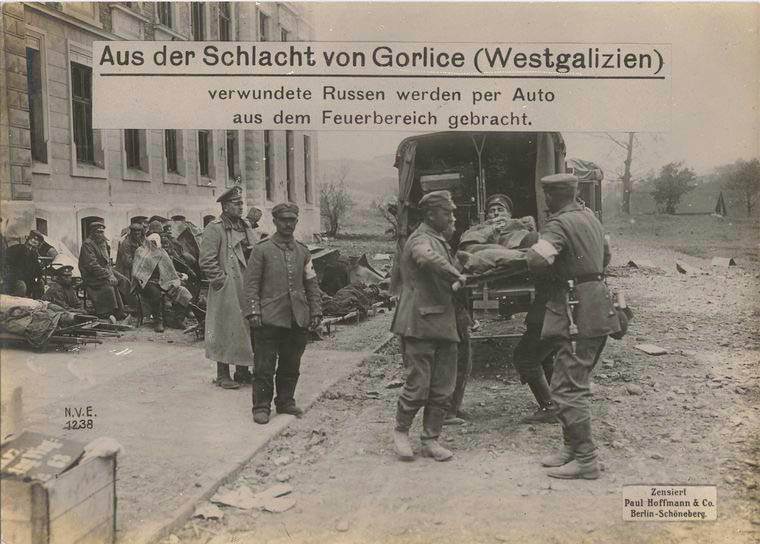
German ambulance at Gorlice
While adoring to acting at the junctions, on April 10, the German command set out to deepen the breakthrough - above all at the junction of the 20 and 9 corps of the 10 army. To implement this fully the enemy failed.
The 10 Army Corps fought three enemy corps.
On this day, trying to clamp the connection in the claws, the enemy pressed hard on the right flank of the 31 infantry division and on the 9 th infantry division (left flank of the corps). To fill the gap between the 9-m and 10-Army Corps was formed by a detachment composed 16-Cavalry Division and infantry brigades (19-th Infantry Kostroma Regiment 5-th Infantry Division and 251-th Infantry Stavuchansky regiment 63-th Infantry Division ) under the leadership of the commander of the 16 th cavalry division, Major General N. G. Volodchenko. By the 16 hours of April 20, at the junction of the corps, considerable Austrian forces concentrated, which swept the right flank of this detachment and advanced on the villages. Zurov.
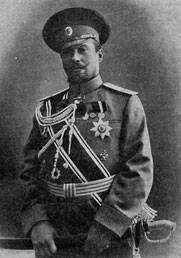
The commander of the 16 Cavalry Division (then the commander of the Combined Equestrian Corps of the 3 Army) Major General N. G. Volodchenko
The 70 Infantry Division, which suffered heavy losses, retreated into the field. Tukhov and was not able to counteract the accumulation of the Austrians. 3-I Caucasian Cossack division concentrated in the field. Ryglitz. The 167 Infantry Regiment of Ostrog (it was on the left flank of the 70 Division) was retreating to the east of Zurov — the Kostroma Infantry Regiment of the Kostroma regiment joined its left flank.
The situation at the junction of the corps was alarming - a front gap had formed. The document testifies: “Ten companies of 122 and 121 of the regiments (31 of the infantry division of the 10 of the army corps - A. About.) at the height of 449 were destroyed by fire and bayonets; in the resulting gap, the enemy poured into the rear of the neighboring areas, but still we still resist. They also held when the enemy occupied Rzhepenik, Biskupi, and in the former trenches of the Kromsky regiment (the 278 th infantry regiment of the 70 th infantry division of the 9 th army corps A. About.) and Biskupi acted his batteries. At this time, it was reported that the fresh German regiment had broken the junction between the 121 and Sedlets regiments (the 261 th infantry regiment of the 61 th infantry division of the 10 th army corps - AO). "
The 3-i Don Cossack Division was sent to this period. The 20 military journal of the Don Cossack regiment noted: “At 2 one o'clock in the afternoon the regiment arrived in the village of Lazi, where it stopped. In 5 hours of the evening, the regiment was alarmed from the village of Lazi on the way to the village of Svatovo. ”
On 12-km space between locations. Tukhov and Zurov were concentrated by a strong grouping of the enemy, which continues to widen the gap between the corps of the 3 Army. To the north of it, the 70 Infantry Division, which had lost its combat capability, left the left flank of the 42 Infantry Division with its withdrawal - this led to the flank regiment of the 20 Division in the evening of 42.
The Russian command pinned particular hopes on the concentrating reserve — parts of the 3 of the Caucasian Army Corps. He was supposed to cover the junction between 9 and 10 in army corps and restore the situation.
By the end of 2, Austrian-German forces were able to go deep into the Russian defense as far as 8 km, the operation was completed. A tactical breakthrough was made. And now it had to be transformed into operational, and then into strategic.
Despite the seeming modesty of the Gorlitsky breakthrough proper, it became the first link in the chain of operations that had far-reaching strategic consequences.
As a result, the Russian armies for the 2 months left Galicia, lost the system of fortresses, suffered huge losses in people and material resources. Despite the fact that the situation on the Russian North-Western Front was strong, a general retreat was necessary, the withdrawal of troops from the "Polish bag". The North-Western Front was weakened. All possible forces were transferred from there to the South-Western Front to parry the success of the enemy.
Strengthened the Austro-Hungarian army. After restoring combat capability, she successfully acted both on the Italian and the Russian and Balkan fronts. The danger to Hungary was eliminated. On the side of the German bloc Bulgaria entered the war, which led to the catastrophe of the Serbian front and, as a result, even greater economic isolation of Russia.
In addition to the evacuation of Poland, the loss of the network of strategic railways (the load on the remaining roads increased, which caused problems in the field of railway transport) —and the maneuverability of the Russian army declined significantly.
The Russian reserves were spent (including the contingent destined for the Bosphorus expedition, which was repeatedly noted by E. von Falkenhain).
In general, the positive results of the operational success of the Russian armies during the 1914 campaign and the Carpathian operation 1915 were lost.
At the same time, tactically, the enemy's Gorlitsky breakthrough should be rated low. Describing it, military experts formulated a number of significant complaints against both the Russian and the German commands. In particular, it was stated that the German command, in spite of the overwhelming superiority in manpower and technology, did not skillfully maneuver during the battle with their troops — which allowed the Russians to freely withdraw at first on the r. Visloka, and then on the river. San The German-Austrians managed to achieve a huge superiority of forces in the direction of a breakthrough, but the lack of maneuver after the breakthrough made it did not give the desired effect. At the same time, the Russians also retreated, not trying to maneuver on the flanks of the advancing enemy to stop the latter - which was quite realistic. Gorlitskaya operation confirmed the importance of heavy artillery in a war of maneuver, showed the great importance of powerful equipment in combat operations. The latter could not resist any valor of the troops deprived of the support of technology - the German troops, unable to withstand direct contact with the Russian troops in melee, with the help of a huge number of shells methodically equalized with the ground Russian trenches, and only then went ahead.
But the troops of the Russian 3 army, which took the main blow of the enemy, were at their best. The very depletion of this army testifies to the high fighting spirit of its commanders and fighters. The exceptional resistance of the infantry of the Russian imperial army demanded tremendous efforts and great sacrifices from the German-Austrian troops.
Sources of
RGVIA. F. 2007. Op. 1. D. 42. H. 5;
Collection of documents of the world imperialist war on the Russian front (1914 - 1917). Gorlitsky operation. M., 1941;
Year of war from 19 July 1914 g. To 19 July 1915 g. M., 1915;
Chronicle of war. - 1915. - No. 40 of;
Reichsarchiv. Der Weltkrieg 1914 - 1918. Bd 7. Berlin, 1931;
Österreich-Ungarns Letzter Krieg 1914 - 1918. Bd ii. Wien, 1931;
Falkengayn E. background. 1914 High Command - 1916 in its most important decisions. M., 1923;
Hoffman M. The war of missed opportunities. M. - L., 1925;
Brusilov A. A. My memories. M., 1983;
Ludendorff E. background. My memories of the war 1914 - 1918 years. M. - Mn., 2005.
Literature
The composition of the German army according to the 1 in May 1915 Propulsion. General Staff Captain B. A. Durov. Warsaw, 1915;
Battle schedule of the Austro-Hungarian army. Compiled from data available in the Intelligence Division of the Headquarters of the Commander-in-Chief of the armies of the South-Western Front to 25 in May 1915. B. m., 1915;
Great War. 1915 year. Essay main operations. Russian Western Front. Pg., 1916;
Rotkirch T. Fon. Breakthrough of the Russian Carpathian Front at Gorlitsy-Tarnov in 1915, Pb., 1921;
Strategic essay on the 1914 war - 1918's. CH 4. M., 1922;
Yu. N. Danilov. Russia in World War 1914 - 1915 Berlin, 1924;
Bonch-Bruevich M.D. Our loss of Galicia in 1915. Part II. Accident in the 3-th army. M. - L., 1926;
Battle of Gorlitsa-Tarnov 2 - 6 of May 1915. An essay on the joint actions of the infantry with artillery. M. - L., 1929;
G. Kellerman. Breakthrough of the 11 of the German Army at Gorlice 2-5 in May 1915. // War and Revolution. - 1934. - March, April;
Kersnovsky A. A. History Russian Army. Tt. 3-4. M., 1994;
Participate in the War (1914-1918). Washington, 1920.
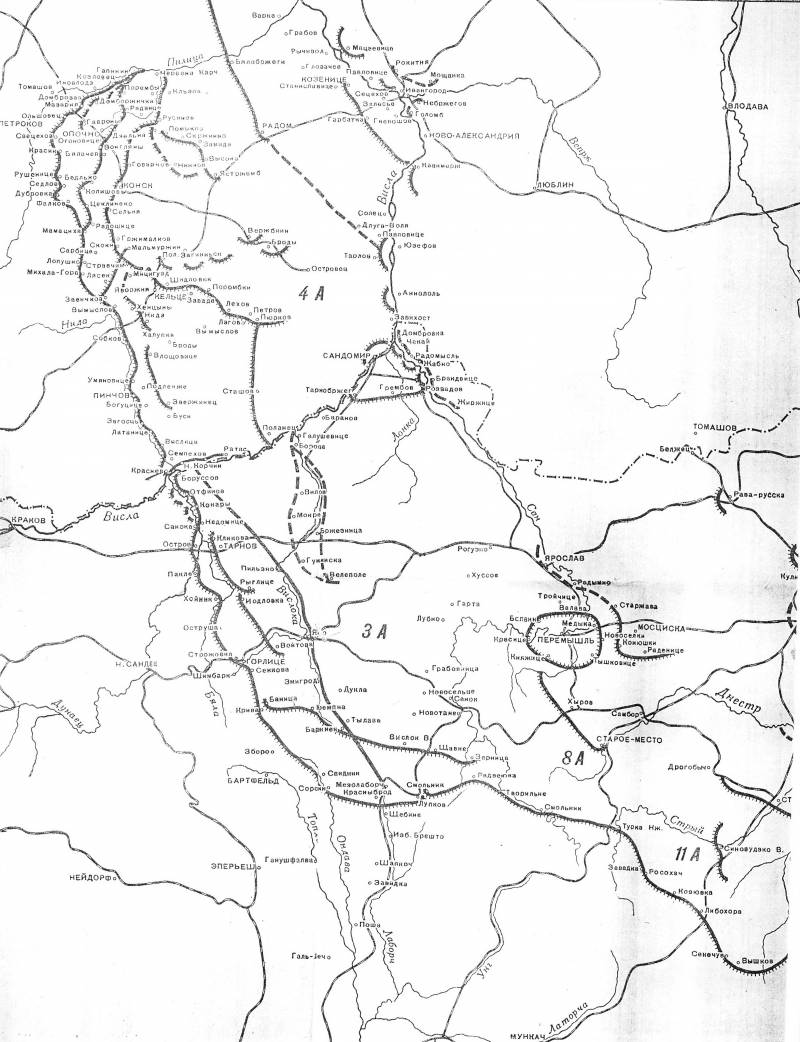
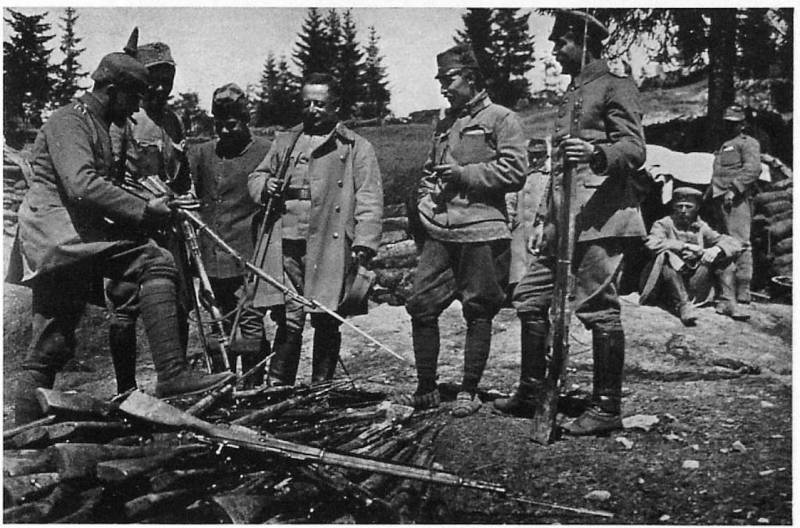
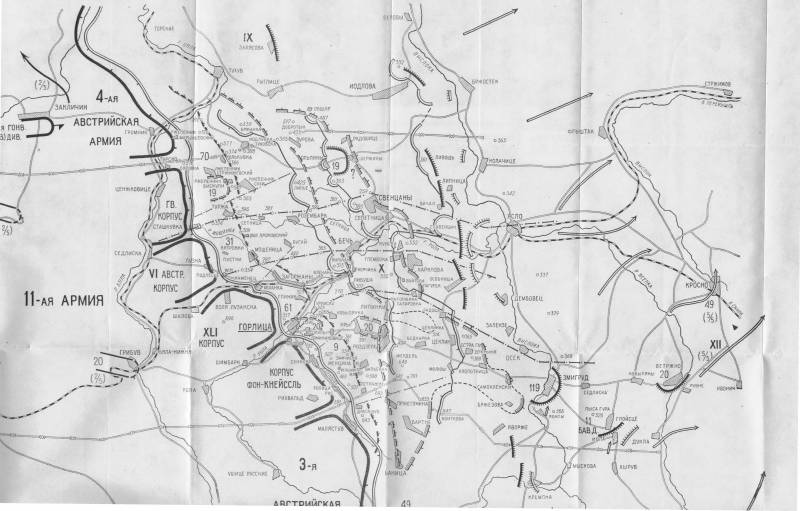
Information